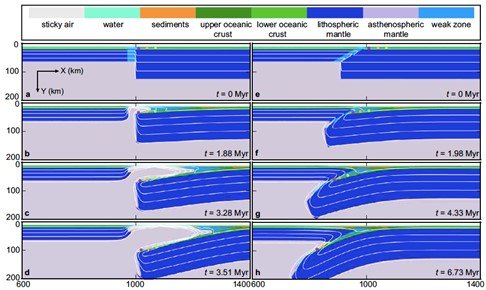Geodynamics Research Lab: Modeling Subduction

In our computational lab, we develop numerical models that simulate processes that control the evolution of solid Earth, focusing particularly on those in subduction zones where a cold and dense tectonic plate sinks into the underlying hot mantle. Plate subduction is a key driving mechanism of plate tectonics and is a critical component of Earth’s evolution. Our models help to deepen our understanding of the dynamics of subduction and Earth’s evolution. They also help to understand a range of important geophysical and geochemical processes that occur in subduction zones, such as earthquakes and volcanism.
Despite the importance of subduction to geodynamics, how it initiates is not well understood. How dense does the plate need to be to subduct? Is lateral tectonic push from neighboring plates required to initiate subduction? To address these questions, we developed a suite of numerical models and investigated how subduction initiated at modern and ancient subduction zones in our recent work (Figure 1) [Zhou and Wada, 2021]. To constrain the models, we used the temperature and pressure conditions that are recorded in rocks that formed or altered during subduction initiation. Based on our modeling results and the compilation of rock records, we found that both the subducting and overriding plates were relatively young (less than 10 million years old) and hot when subduction initiated at many of localities that we studied, indicating that the subducting plate was not significantly older or denser than the overriding plate. Further, we found that at these localities, the subduction likely initiated in the presence of lateral tectonic push, which caused the plate to thrust under another plate (i.e., “induced” subduction initiation in Figure 1e–h) rather than plunging into the underlying mantle due to gravitational instability (i.e., “spontaneous” subduction initiation in Figure 1a–d).
In our lab, we are addressing a range of other subduction-related problems, including the thermal and petrological evolution of subduction zones, the deformation of the overriding plate, the pattern of mantle flow, the migration and distribution of fluids (water and melts) in subduction zones, and the evolution of the volcanic arc and the back-arc (i.e., the region behind the arc). For updates on our research, please visit our website (https://geodynamics.umn.edu/).

Read the full Article in Nature Communications
Authored by Dr. Ikuko Wada, Assistant Professor, Department of Earth & Environmental Sciences